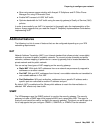
Preparing to configure your network
Issue 4 May 2005 29
● Allow voice-secure communication with Avaya’s IP Softphone and IP Office Phone
Manager Pro using VPNremote Client
● Enable NAT traversal of H.323 VoIP traffic
● Optimize bandwidth for VoIP traffic using the security gateway’s Quality of Service (QoS)
policies
In order to successfully use VoIP it is important to thoroughly plan the implementation of the
feature. Avaya suggests that you read the Avaya IP Telephony Implementation Guide before
implementing VoIP.
Additional features
The following is a list of some of features that can be configured depending on your VPN
networking requirements.
NAT
Network Address Translation (NAT) is an Internet standard that allows private (nonroutable)
networks to connect to public (routable) networks. To connect private networks and public
networks, address mapping is performed on a security gateway that is located between the
private network and the public network.
You can set up three types of NAT mapping on the security gateway:
● Static NAT. With static NAT, addresses from one network are permanently mapped to
addresses on another network.
● Port NAT. With port NAT, addresses from internal, nonroutable networks are translated to
one routable address in Port NAT.
● Port Redirection. With port redirection, addresses from a specific IP address and a
specific port are redirected to another IP address and port.
By default, NAT is enabled and the Share public address to reach the Internet feature is
selected. NAT affects only clear traffic.
SNMP
The VPNmanager uses the SNMP protocol to monitor the security gateway. The security
gateway includes a SNMP agent that supports MIB-II and a proprietary MIB. This agent is
read-only and cannot be used to configure the security gateway. The agent can send traps to a
list of trap agents that you configure. SNMPv1, SNMPv2c, or VNMPv3 can be selected.


















